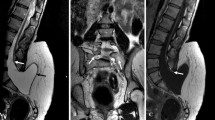Abstract
Objective
To compare the utility of constructive interference in steady-state (CISS) sequence over T2-weighted (T2W) sequence in the accurate delineation of the tethering element on magnetic resonance (MR) imaging in patients of tethered cord syndrome (TCS) and correlation with intraoperative findings.
Methods
MR findings of fifty-six consecutive patients with operative findings of TCS were studied. The intraoperative findings of all patients were studied and compared with the preoperative imaging findings on T2W imaging and CISS images.
Results
CISS images provided more information than T2W imaging. The overall sensitivity of CISS in MR evaluation of patients with TCS was higher (99.17%) as compared with the T2W sequence (71.48%) especially in the detection of precise position/extent of tethered cord, assessment of filum terminale thickening, detection of a fibrous spur in cases of split cord malformation, detection of dorsal dermal sinus, and evaluation of its precise extent and ramifications. The area under the ROC curve was higher with CISS (0.99) than with T2W sequence (0.85) which reflects its good predictive value as a screening test. This information was useful to the operating surgeon.
Conclusion
CISS sequence for imaging TCS can help enhance the overall surgical outcome of the patients ensuring completeness of the surgery. CISS should be routinely performed in the work-up of patients with tethered cord syndrome.




Similar content being viewed by others
References
Lew SM, Kothbauer KF (2007) Tethered cord syndrome: an updated review. Pediatr Neurosurg 43(3):236–248
Hertzler DA, De Powell JJ, Stevenson CB, Mangano FT (2010) Tethered cord syndrome: a review of the literature from embryology to adult presentation. Neurosurg Focus 29(1):E1
Bui CJ, Tubbs RS, Oakes WJ (2007) Tethered cord syndrome in children: a review. Neurosurg Focus 23(2):E2
Raghavan N, Barkovich AJ, Edwards M, Norman D (1989) MR imaging in the tethered spinal cord syndrome. AJR. Am J Roentgenol 152(4):843–852
Radmanesh F, Nejat F, El Khashab M (2010) Dermal sinus tract of the spine. Child’s Nerv Syst: ChNS: official journal of the International Society for Pediatric Neurosurgery 26(3):349–357
Weissert M, Gysler R, Sörensen N (1989) The clinical problem of the tethered cord syndrome--a report of 3 personal cases. ZeitschriftfürKinderchirurgie: organ der Deutschen, der Schweizerischen und der OsterreichischenGesellschaftfürKinderchirurgie = Surgery in infancy and childhood 44(5):275–279
Ostling LR, Bierbrauer KS, Kuntz C (2012) Outcome, reoperation, and complications in 99 consecutive children operated for tight or fatty filum. World Neurosurgery 77(1):187–191
Drake JM (2006) Occult tethered cord syndrome: not an indication for surgery. J Neurosurg 104(5 Suppl):305–308
Selden NR (2006) Occult tethered cord syndrome: the case for surgery. J Neurosurg 104(5 Suppl):302–304
Steinbok P, Garton HJL, Gupta N (2006) Occult tethered cord syndrome: a survey of practice patterns. J Neurosurg 104(5 Suppl):309–313
Yamada S, Won DJ (2007) Occult tethered cord. J Neurosurg 106(5 Suppl):411–413 author reply 413–4
Rosahl SK, Kassem O, Piepgras U, Hellwig D, Samii M (2005) High-resolution constructive interference in steady-state imaging in tethered cord syndrome: technical note. Surg Neurol 63(4):372–374
Hingwala D, Chatterjee S, Kesavadas C, Thomas B, Kapilamoorthy TR (2011) Applications of 3D CISS sequence for problem-solving in neuroimaging. Ind J Radiol Imag 21(2):90–97
Niggemann P, Sarikaya-Seiwert S, Beyer HK, Sobottke R (2011) Features of positional magnetic resonance imaging in tethered cord syndrome. Clin Neuroradiol 21(1):11–15
Rinaldi F, Cioffi FA, Columbano L, Krasagakis G, Bernini FP (2005) Tethered cord syndrome. J Neurosurg Sci 49(4):131–135 discussion 135
Ramli N, Cooper A, Jaspan T (2001) High-resolution CISS imaging of the spine. Br J Radiol 74(885):862–873
Chavhan GB, Babyn PS, Jankharia BG, Cheng H-LM, Shroff MM (2008) Steady-state MR imaging sequences: physics, classification, and clinical applications. Radiographics: a review publication of the Radiological Society of North America, Inc 28(4):1147–1160
Hashiguchi K, Morioka T, Fukui K, Miyagi Y, Mihara F, Yoshiura T, Nagata S, Sasaki T (2006) Usefulness of constructive interference in steady-state magnetic resonance imaging in the presurgical examination for lumbosacral lipoma. J Neurosurg 103:537–543. https://doi.org/10.3171/ped.2005.103.6.0537
Hashiguchi K et al (2007) Feasibility and limitation of constructive interference in steady-state (CISS) MR imaging in neonates with lumbosacral myeloschisis. Neuroradiology. 49(7):579–585
Hossein J, Fariborz F, Mehrnaz R, Babak R (2018) Evaluation of diagnostic value and T2-weighted three-dimensional isotropic turbo spin-echo (3D-SPACE) image quality in comparison with T2-weighted two-dimensional turbo spin-echo (2D-TSE) sequences in lumbar spine MR imaging. Eur J Radiol Open 6:36–41. Published 2018 Dec 28. https://doi.org/10.1016/j.ejro.2018.12.003
Author information
Authors and Affiliations
Corresponding author
Ethics declarations
Conflict of interest
On behalf of all the authors, the corresponding author states that there is no conflict of interest.
Additional information
Publisher’s note
Springer Nature remains neutral with regard to jurisdictional claims in published maps and institutional affiliations.
Rights and permissions
About this article
Cite this article
Sankhe, S., Dang, G., Mathur, S. et al. Utility of CISS imaging in the management of tethered cord syndrome. Childs Nerv Syst 37, 217–223 (2021). https://doi.org/10.1007/s00381-020-04789-y
Received:
Accepted:
Published:
Issue Date:
DOI: https://doi.org/10.1007/s00381-020-04789-y




